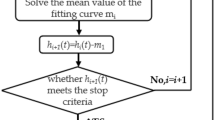Abstract
In order to solve structural multi-damage identification problem, a two-stage damage detection method based on energy balance equation and evidence fusion is presented. First, a Frequency Change Identification (FCI) method and Modal Strain Energy Dissipation Ratio (MSEDR) method are utilized to preliminarily identify structural damage locations, and then a Fusion Damage Localization (FDL) method based on evidence theory is proposed to precisely detect damage locations. The FDL method mainly utilizes evidence theory to combine both the FCI localization information and the MSEDR localization information. Thus, more precise damage localization information can be acquired. After the damaged locations are determined, an Energy Balance Equation (EBE) index is presented to identify structural damage extent. Considering that strain energy dissipation should be equal to the change of modal strain energy, a quartic EBE equation is deduced, and structural damage extent can be obtained through the solution of the equation. An average quantification index is also proposed to improve identification precision. The simulation results demonstrate that the FDL method can perfectly detect structural damage locations, and the EBE index and average index can identify structural damage extent.
Similar content being viewed by others
References
Salawu, O.S.: Detection of structural damage through changes in frequency: a review. Eng. Struct. 19, 718–723 (1997)
Hearn, G., Testa, R.B.: Modal analysis for damage detection in structures. J. Struct. Eng. 117, 3042–3063 (1991)
Dong, C., Fan, L.C., Chen, Z.Y.: Theory and method for structural intelligent health diagnosis. China Railw. Sci. 23, 11–24 (2002)
Messina, A., Williams, E.J., Contursi, T.: Structural damage detection by a sensitivity and statistical-based method. J. Sound Vib. 216, 791–808 (1998)
Law, S.S., Shi, Z.Y., Zhang, L.M.: Structural damage detection from incomplete and noisy modal data. J. Eng. Mech. 124, 1280–1288 (1998)
Shi, Z.Y., Law, S.S., Zhang, L.M.: Optimum sensors placement for structural damage detection. J. Eng. Mech. 126, 1173–1179 (2000)
Shi, Z.Y., Law, S.S., Zhang, L.M.: Damage localization by directly using incomplete mode shapes. J. Eng. Mech. 126, 656–660 (2000)
Guo, H., Zhang, L.: A weighted balance evidence theory for structural multiple damage localization. Comput. Methods Appl. Mech. Eng. 195, 6225–6238 (2006)
Shi, Z.Y., Law, S.S., Zhang, L.M.: Structural damage localization from modal strain energy change. J. Sound Vib. 218(5), 825–844 (1998)
Li, H., Yang, H., Hu, S.L.J.: Modal strain energy decomposition method for damage localization in 3D frame structures. J. Eng. Mech. 132(9), 941–951 (2006)
Petro, S.H., Gangarao, S.H.E., Venkatappa, S.: Damage detection using vibration measurement. In: Proceeding of International Modal Analysis Conference, Orlando, FL, pp. 113–119 (1997)
Venkatappa, S.G.: Damage detection using vibration measurement. Master of Science Thesis, West Virginia University (1997)
Stubbs, N., Kim, J.T., Farrar, C.R.: Field verification of a nondestructive damage localization and severity estimation algorithm. In: Proc. of IMAC, Connecticut, USA, pp. 210–218. Society of Experimental Mechanics, Bethel (1995)
Sazonov, E., Klinkhachorn, P.: Optimal spatial sampling interval for damage detection by curvature or strain energy mode shapes. J. Sound Vib. 285(4–5), 783–801 (2005)
Liu, H., Qu, W.L., Yuan, R.Z.: Structural damage detection method based on the theory of dissipation ratio of modal strain energy. J. Vib. Shock 23(2), 118–121 (2004) (in Chinese)
Hu, H., Wang, B.-T., Lee, C.-H., et al.: Damage detection of surface cracks in composite laminates using modal analysis and strain energy method. Compos. Struct. 74(4), 399–405 (2006)
Hu, H., Wu, C.: Development of scanning damage index for the damage detection of plate structures using modal strain energy method. Mech. Syst. Signal Process. 23(2), 274–287 (2009)
Shafer, G.: A Mathematical Theory of Evidence. Princeton University Press, Princeton (1976)
Du, W.J., Xie, W.X.: Evidence combination methods in D-S evidence theory. Syst. Eng. Electron. 21(12), 92–94 (1999)
Author information
Authors and Affiliations
Corresponding author
Rights and permissions
About this article
Cite this article
Guo, H.Y., Li, Z.L. Two-Stage Multi-damage Detection Method Based on Energy Balance Equation. J Nondestruct Eval 30, 186–200 (2011). https://doi.org/10.1007/s10921-011-0107-7
Received:
Accepted:
Published:
Issue Date:
DOI: https://doi.org/10.1007/s10921-011-0107-7




